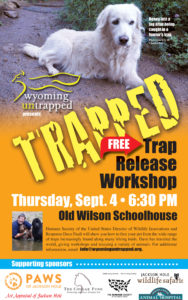Learn How to Spring Your Dog From a Trap
Jackson Hole News and Guide
POSTED: WEDNESDAY, AUGUST 27, 2014 4:30 AM
Think what you don’t know won’t hurt you? Think again.
While there are plenty of risks when out and about with your dog, the threat of a trap is not the first thing that comes to mind. Yet trapping is something all dog owners who live and play on public land should be aware of.
Today’s increased demand for fur by foreigners means high prices for pelts and more traps. With more traps out there, and a general increase in people recreating with their dogs on public land, the possibility of your pet being accidentally caught in a trap is perhaps higher than ever before.
And indeed, accidental trapping incidents are happening, right here around Jackson Hole. Last year, at least four dogs were reported caught in traps intended for wildlife when out with their owners — two south of Wilson, one north of Jackson and one down near Alpine. All these dogs survived, but some did not escape without injury.
Trapping regulations vary from state to state; Wyoming Game and Fish Commission is our regulating agency. There are three kinds of traps allowed here: leghold, snare, and conibear. Bait is used. All traps are required to have permanent identifying tags of some kind.
For furbearing animals that are trapped for their pelts, like beaver, muskrat, mink, weasel, badger, marten, or bobcat, there is a specific trapping season. This varies according to species, but generally runs from October to April. A license is required to trap furbearing animals; some areas have quotas, and other areas are closed.
Animals deemed predators, however, do not require a trapping license and may be trapped at any time of year in many areas. According to the Game and Fish, predatory animals include coyote, jackrabbit, porcupine, raccoon, red fox, skunk, stray cat or gray wolf in certain areas.
This means traps can be out there year-round. But where? A great question, and one that is difficult to answer. Right now, there is no exact information on how many traps are out there, let alone where they may be. Regulations require that lethal traps be set at least 30 feet from a designated road. There are no setback requirements from trails.
For those of us who love to get out on public land with our dogs, being aware will help. But the best line of defense is to learn how to free your dog from the different kinds of traps.
Wyoming Untrapped, a nonprofit dedicated to creating a safe, humane environment for people, pets, and wildlife, is presenting a workshop at 6:30 p.m. Sept. 4 at Old Wilson Schoolhouse Community Center.
It can be tricky to release a dog from a trap and this workshop will offer you the opportunity to see how it is done firsthand with each of the three traps, and to talk about what tools may be useful. If you can’t make it, there is a video on their website, WyomingUntrapped.org, of a previous trap-releasing presentation. Although this is knowledge you never hope to have to call on, for dog owners in this area it is well worth knowing.
Keep in mind that in Wyoming, there is no required reporting for non-target animals caught, except if it is a game animal or protected species like wolverine or lynx that has a life-threatening injury or has been killed.
What this means is if a dog is found accidentally caught by a trapper, the trapper is required to release the dog — but nothing else. The trapper is under no obligation to contact the dog’s owner if the dog is wearing identification, and trappers bear no responsibility for dogs trapped, the damages done to them, or if the dog has been killed.
In an effort to get an idea of where our dogs may be in most danger, Wyoming Untrapped also requests anyone who has a dog who has been accidentally trapped, or knows of one, to contact them.
Trappers are not required to check leghold traps more frequently than every 72 hours in Wyoming, and can go up to 13 days before checking on snares. You may not hear a peep from your dog if they are caught in a trap, and your only hope will be seeing the dog in a trap — all the more reason to keep your dog in sight, be able to reliably call your dog to you, and keep them nearby when hiking.
Short of working to change the rules, if you are armed with this skill and knowledge about how to release a trap, you will be doing the best you can for your best canine friend.
Krissi Goetz is a trainer with JH Positive Training and a volunteer with Western Border Collie Rescue. She hopes to see lots of you at Sept. 4 at Old Wilson Schoolhouse.
http://www.jhnewsandguide.com/valley/columnists/learn-how-to-spring-your-dog-from-a-trap/article_deae670c-4608-5671-9647-c6ed190fa12b.html



